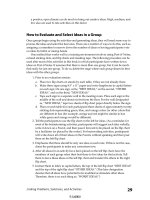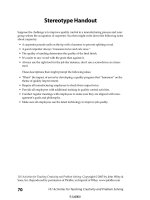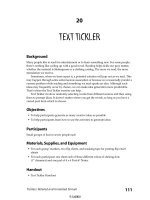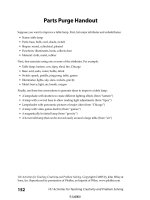investment banking workbook 400 problem solving exercises
Bạn đang xem bản rút gọn của tài liệu. Xem và tải ngay bản đầy đủ của tài liệu tại đây (8.92 MB, 293 trang )
Contents
Cover
Series
Title Page
Copyright
About the Authors
CONTACT THE AUTHORS
Acknowledgements
Introduction
TARGET AUDIENCE
CONTENT AND APPLICATIONS
Chapter 1: Comparable Companies Analysis
CHAPTER 1 ANSWERS AND RATIONALE
Chapter 2: Precedent Transactions Analysis
CHAPTER 2 ANSWERS AND RATIONALE
Chapter 3 :Discounted Cash Flow Analysis
CHAPTER 3 ANSWERS AND RATIONALE
Chapter 4: Leveraged Buyouts
CHAPTER 4 ANSWERS AND RATIONALE
Chapter 5: LBO Analysis
CHAPTER 5 ANSWERS AND RATIONALE
Chapter 6: Sell-Side M&A
CHAPTER 6 ANSWERS AND RATIONALE
Chapter 7: Buy-Side M&A
CHAPTER 7 ANSWERS AND RATIONALE
Founded in 1807, John Wiley & Sons is the oldest independent
publishing company in the United States. With offices in North
America, Europe, Australia and Asia, Wiley is globally committed to
developing and marketing print and electronic products and services
for our customers' professional and personal knowledge and
understanding.
The Wiley Finance series contains books written specifically for
finance and investment professionals as well as sophisticated
individual investors and their financial advisors. Book topics range
from portfolio management to e-commerce, risk management,
financial engineering, valuation and financial instrument analysis, as
well as much more.
For a list of available titles, visit our Web site at
www.WileyFinance.com.
Cover image: Wiley
Cover design: (Stock Board) © David Pollack / Corbis
Copyright © 2013 by Joshua Rosenbaum and Joshua Pearl. All rights
reserved.
Published by John Wiley & Sons, Inc., Hoboken, New Jersey.
Published simultaneously in Canada.
No part of this publication may be reproduced, stored in a retrieval
system, or transmitted in any form or by any means, electronic,
mechanical, photocopying, recording, scanning, or otherwise, except
as permitted under Section 107 or 108 of the 1976 United States
Copyright Act, without either the prior written permission of the
Publisher, or authorization through payment of the appropriate percopy fee to the Copyright Clearance Center, Inc., 222 Rosewood
Drive, Danvers, MA 01923, (978) 750-8400, fax (978) 646-8600, or
on the Web at www.copyright.com. Requests to the Publisher for
permission should be addressed to the Permissions Department, John
Wiley & Sons, Inc., 111 River Street, Hoboken, NJ 07030, (201)
748-6011,
fax
(201)
748-6008,
or
online
at
/>Limit of Liability/Disclaimer of Warranty: While the publisher and
author have used their best efforts in preparing this book, they make
no representations or warranties with respect to the accuracy or
completeness of the contents of this book and specifically disclaim
any implied warranties of merchantability or fitness for a particular
purpose. No warranty may be created or extended by sales
representatives or written sales materials. The advice and strategies
contained herein may not be suitable for your situation. You should
consult with a professional where appropriate. Neither the publisher
nor author shall be liable for any loss of profit or any other
commercial damages, including but not limited to special, incidental,
consequential, or other damages.
For general information on our other products and services or for
technical support, please contact our Customer Care Department
within the United States at (800) 762-2974, outside the United States
at (317) 572-3993 or fax (317) 572-4002.
Wiley publishes in a variety of print and electronic formats and by
print-on-demand. Some material included with standard print
versions of this book may not be included in e-books or in print-ondemand. If this book refers to media such as a CD or DVD that is not
included in the version you purchased, you may download this
material at . For more information
about Wiley products, visit www.wiley.com.
ISBN 978-1-118-45611-8 (Paperback); ISBN 978-1-118-65621-1
(cloth);
ISBN 978-1-118-28125-3 (cloth + models);
ISBN 978-1-118-47220-0 (paper); ISBN 978-1-118-41985-4 (ebk);
ISBN 978-1-118-42161-1 (ebk); ISBN 978-1-118-69505-0 (ebk)
About the Authors
JOSHUA ROSENBAUMis a Managing Director at UBS Investment
Bank in the Global Industrial Group. He originates, structures, and
advises on M&A, corporate finance, and capital markets
transactions. Previously, he worked at the International Finance
Corporation, the direct investment division of the World Bank. He
received his AB from Harvard and his MBA with Baker Scholar
honors from Harvard Business School.
JOSHUA PEARLis an investment analyst at Brahman Capital Corp.
Previously, he structured and executed leveraged loan and high yield
bond financings, as well as leveraged buyouts and restructurings as a
Director at UBS Investment Bank in Leveraged Finance. Prior to
UBS, he worked at Moelis & Company and Deutsche Bank. He
received his BS in Business from Indiana University's Kelley School
of Business.
CONTACT THE AUTHORS
Please feel free to contact JOSHUA ROSENBAUMand JOSHUA
PEARL with any questions, comments, or suggestions for future
editions at
Acknowledgments
We would like to highlight the contributions made by Joseph
Gasparro toward the successful production of this workbook. His
contributions were multi-dimensional and his unwavering
enthusiasm, insights, and support were nothing short of exemplary. In
general, Joe's work ethic, creativity, “can-do” attitude, and
commitment to perfection are a true inspiration. We look forward to
great things from him in the future.
We would also like to thank Ezra Faham for all his efforts and
contributions in the completion of this workbook.
Introduction
This workbook is designed for use both as a companion to our book,
Investment Banking: Valuation, Leveraged Buyouts, and Mergers
& Acquisitions, Second Edition, as well as on a standalone basis.
Investment Banking focuses on the primary valuation methodologies
currently used on Wall Street—namely, comparable companies
analysis, precedent transactions analysis, discounted cash flow
(DCF) analysis, and leveraged buyout (LBO) analysis, as well as
detailed mergers & acquisitions (M&A) analysis from both a sellside and buy-side perspective. Our workbook seeks to help solidify
knowledge of these core financial topics as true mastery must be
tested, honed, and retested over time. We envision the workbook
being used as a self-help tool for students, job seekers, and existing
finance professionals, as well as in formal classroom and training
settings.
The workbook provides a mix of multi-step problem set exercises,
as well as multiple choice and essay questions. We also provide a
comprehensive answer key that aims to truly teach and explain as
opposed to simply identify the correct answer. Therefore, the
answers themselves are an effective learning tool. The level of
difficulty for these exercises and questions ranges from basic to
advanced. The format of the workbook is designed to optimize
mastering the critical financial tools discussed in Investment
Banking and therefore corresponds to its chapters, as shown below:
Chapter 1: Comparable Companies Analysis
Chapter 2: Precedent Transactions Analysis
Chapter 3: Discounted Cash Flow Analysis
Chapter 4: Leveraged Buyouts
Chapter 5: LBO Analysis
Chapter 6: Sell-Side M&A
Chapter 7: Buy-Side M&A
TARGET AUDIENCE
We are confident that this workbook will enable users to take their
learning to the next level in terms of understanding and applying the
critical financial tools necessary to be an effective finance
professional. Consequently, our target audience for the workbook
overlaps with Investment Banking—namely current and aspiring
investment bankers, students, career changers, private equity and
hedge fund professionals, sell-side research analysts, and finance
professionals at corporations (including members of business
development, finance, and treasury departments). We also believe
our workbook is highly beneficial to those attorneys, consultants, and
accountants focused on M&A, corporate finance, capital raising, and
other transaction advisory services.
At the same time, our workbook is designed to serve as the ultimate
teaching tool for finance professors, instructors, and trainers. The
multiple choice questions are complemented by rigorous multi-step
exercises designed to ensure mastery of key modeling conventions
and financial calculations. It is the perfect complement to classroom
or online instruction, as well as core course reading materials. In
fact, Investment Banking and this workbook are designed in an
integrated manner so as to provide a foundation around which a
professor, instructor, or trainer can build an entire course.
CONTENT AND APPLICATIONS
The multi-step exercises are instrumental for learning the
calculations and modeling skills behind the core valuation, LBO, and
M&A tools. Once mastered, these exercises provide a solid
foundation for financial modeling (including crafting financial
projections), and performing comparable companies, precedent
transactions, DCF and LBO Analysis, as well as comprehensive
merger consequences analysis (including the creation of pro forma
financial statements). They also provide a sound understanding of
more
complex
calculations
and
nuances
involving
accretion/(dilution) analysis, exchange ratios, premiums paid,
treasury stock method (TSM), capital asset pricing model (CAPM),
weighted average cost of capital (WACC), goodwill, tangible and
intangible write-ups, deferred tax liabilities, and numerous other
critical topics.
The multiple choice questions are designed to be used on both an
individual as well as collective basis. In other words, individual
questions from each chapter can be mixed and matched to
accommodate any testing, learning, or training format. At the same,
taken collectively for a given financial topic, the questions and
exercises provide an integrated and multidimensional approach that
can be used to teach and learn the material, whether individually, in
the classroom, or for a training program.
CHAPTER 1
Comparable Companies Analysis
1) Using the information provided for Gasparro Corp., complete the
questions regarding fully diluted shares outstanding
a. Calculate Gasparro Corp.'s in-the-money options/warrants
____________________________________________________
b. Calculate proceeds from in-the-money options/warrants
____________________________________________________
c. Calculate net new shares from the options/warrants
____________________________________________________
d. Calculate fully diluted shares outstanding
____________________________________________________
2) Using the prior answers and information, as well as the balance
sheet data below, calculate Gasparro's equity value and enterprise
value
a.Calculate equity value
____________________________________________________
b. Calculate enterprise value
____________________________________________________
3) Using the information provided for Gasparro, complete the
questions regarding non-recurring items
a. Calculate adjusted LTM gross profit for Gasparro, assuming
the $30.0 million inventory charge is added back to COGS
____________________________________________________
b. Calculate adjusted LTM EBIT
____________________________________________________
c. Calculate adjusted LTM EBITDA
____________________________________________________
d. Calculate adjusted LTM net income
____________________________________________________
4) Using the prior answers and information, complete the questions
regarding Gasparro's LTM return on investment ratios
a. Calculate return on average invested capital
____________________________________________________
b. Calculate return on average equity
____________________________________________________
c. Calculate return on average assets
____________________________________________________
d. Calculate implied annual dividend per share
____________________________________________________
5) Using the prior answers and information, complete the questions
regarding Gasparro's LTM credit statistics
a. Calculate debt-to-total capitalization
____________________________________________________
b. Calculate total debt-to-EBITDA
____________________________________________________
c. Calculate net debt-to-EBITDA
____________________________________________________
d. Calculate EBITDA-to-interest expense
____________________________________________________
e. Calculate (EBITDA – capex)-to-interest expense
____________________________________________________
f. Calculate EBIT-to-interest expense
____________________________________________________
6) Using the prior answers and information, calculate Gasparro's
trading multiples
a. Calculate Gasparro Corp.'s LTM enterprise value-to-sales
____________________________________________________
b. Calculate 2012E enterprise value-to-EBITDA
____________________________________________________
c. Calculate 2013E enterprise value-to-EBIT
____________________________________________________
d. Calculate 2014E P/E
____________________________________________________
e. Calculate 2014E FCF yield
____________________________________________________
7) Using the prior answers and information, calculate Gasparro's
growth rates
a. Calculate Gasparro's historical one-year sales growth
____________________________________________________
b. Calculate historical two-year EBITDA compounded annual
growth rate
____________________________________________________
c. Calculate estimated one-year FCF growth
____________________________________________________
d. Calculate estimated two-year EPS CAGR
____________________________________________________
8) Using the information provided for ValueCo's peers, complete
the questions regarding LTM profitability margins
a. Calculate BuyerCo's gross profit margin
____________________________________________________
b. Calculate Sherman Co.'s EBITDA margin
____________________________________________________
c. Calculate Pearl Corp.'s EBIT margin
____________________________________________________
d. Calculate Kumra Inc.'s net income margin
____________________________________________________
e. Calculate the mean EBITDA margin
____________________________________________________
f. Calculate the median EBIT margin
____________________________________________________
9) Using the information below, calculate the LTM leverage and
coverage ratios for ValueCo's peers
a. Calculate BuyerCo's debt-to-total capitalization (using market
value of equity)
____________________________________________________
b. Calculate Sherman Co.'s debt-to-EBITDA ratio
____________________________________________________
c. Calculate Pearl Corp.'s net debt-to-EBITDA ratio
____________________________________________________
d. Calculate Kumra Inc.'s EBITDA-to-interest expense ratio
____________________________________________________
e. Calculate Kumra Inc.'s (EBITDA – capex)-to-interest
expense ratio
____________________________________________________
f. Calculate Kumra Inc.'s EBIT-to-interest expense ratio
____________________________________________________
g. Calculate the mean debt-to-EBITDA leverage ratio
____________________________________________________
h. Calculate the median EBITDA-to-interest expense ratio
____________________________________________________
10) Using the information below, calculate the LTM valuation
multiples for ValueCo's peers
a. Calculate BuyerCo's enterprise value-to-sales multiple
____________________________________________________
b. Calculate Sherman Co.'s enterprise value-to-EBITDA
multiple
____________________________________________________
c. Calculate Pearl Corp.'s enterprise value-to-EBIT multiple
____________________________________________________
d. Calculate Kumra Inc.'s P/E multiple
____________________________________________________
e. Calculate the mean enterprise value-to-EBITDA multiple
____________________________________________________
f. Calculate the median P/E ratio
____________________________________________________
11) Using the information below, calculate ValueCo's implied
valuation ranges using the company's LTM EBITDA
a. Calculate ValueCo's implied enterprise value range
____________________________________________________
b. Calculate ValueCo's implied equity value range
____________________________________________________
c. Calculate ValueCo's implied share price range
____________________________________________________
12) Using the information below, calculate ValueCo's implied
valuation ranges using the company's LTM net income
a. Calculate ValueCo's implied equity value range
____________________________________________________
b. Calculate ValueCo's implied share price range
____________________________________________________
13) Which of the following is the correct order of steps to complete
comparable companies analysis?
I. Locate the Necessary Financial Information
II. Select the Universe of Comparable Companies
III. Spread Key Statistics, Ratios, and Trading Multiples
IV. Determine Valuation
V. Benchmark the Comparable Companies
A. II, I, III, V, IV
B. I, II, III, IV, V
C. II, I, III, IV, V
D. III, I, IV, V, IV
14) All of the following are business characteristics that can be
used to select comparable companies EXCEPT
A. Products and Services
B. Distribution Channels









